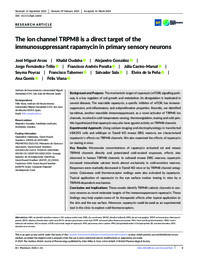Please use this identifier to cite or link to this item:
https://hdl.handle.net/11000/32391Full metadata record
| DC Field | Value | Language |
|---|---|---|
| dc.contributor.author | Arcas, José Miguel | - |
| dc.contributor.author | OUDAHA, KHALID | - |
| dc.contributor.author | González, Alejandro | - |
| dc.contributor.author | Fernández-Trillo, Jorge | - |
| dc.contributor.author | Peralta, Francisco Andrés | - |
| dc.contributor.author | Castro-Marsal, Júlia | - |
| dc.contributor.author | Poyraz, Seyma | - |
| dc.contributor.author | Taberner, Francisco | - |
| dc.contributor.author | Sala, Salvador | - |
| dc.contributor.author | De la Peña García, Elvira | - |
| dc.contributor.author | Gómis, Ana | - |
| dc.contributor.author | Viana, Félix | - |
| dc.contributor.other | Instituto de Neurociencias | es_ES |
| dc.date.accessioned | 2024-07-01T10:14:19Z | - |
| dc.date.available | 2024-07-01T10:14:19Z | - |
| dc.date.created | 2024 | - |
| dc.identifier.citation | British Journal of Pharmacology, 2024 May 13 | es_ES |
| dc.identifier.issn | 1476-5381 | - |
| dc.identifier.uri | https://hdl.handle.net/11000/32391 | - |
| dc.description.abstract | Background and purpose: The mechanistic target of rapamycin (mTOR) signalling pathway is a key regulator of cell growth and metabolism. Its deregulation is implicated in several diseases. The macrolide rapamycin, a specific inhibitor of mTOR, has immunosuppressive, anti-inflammatory and antiproliferative properties. Recently, we identified tacrolimus, another macrolide immunosuppressant, as a novel activator of TRPM8 ion channels, involved in cold temperature sensing, thermoregulation, tearing and cold pain. We hypothesized that rapamycin may also have agonist activity on TRPM8 channels. Experimental approach: Using calcium imaging and electrophysiology in transfected HEK293 cells and wildtype or Trpm8 KO mouse DRG neurons, we characterized rapamycin's effects on TRPM8 channels. We also examined the effects of rapamycin on tearing in mice. Key results: Micromolar concentrations of rapamycin activated rat and mouse TRPM8 channels directly and potentiated cold-evoked responses, effects also observed in human TRPM8 channels. In cultured mouse DRG neurons, rapamycin increased intracellular calcium levels almost exclusively in cold-sensitive neurons. Responses were markedly decreased in Trpm8 KO mice or by TRPM8 channel antagonists. Cutaneous cold thermoreceptor endings were also activated by rapamycin. Topical application of rapamycin to the eye surface evokes tearing in mice by a TRPM8-dependent mechanism. Conclusion and implications: These results identify TRPM8 cationic channels in sensory neurons as novel molecular targets of the immunosuppressant rapamycin. These findings may help explain some of its therapeutic effects after topical application to the skin and the eye surface. Moreover, rapamycin could be used as an experimental tool in the clinic to explore cold thermoreceptors. | es_ES |
| dc.format | application/pdf | es_ES |
| dc.format.extent | 23 | es_ES |
| dc.language.iso | eng | es_ES |
| dc.publisher | WILEY | es_ES |
| dc.rights | info:eu-repo/semantics/openAccess | es_ES |
| dc.rights.uri | http://creativecommons.org/licenses/by-nc-nd/4.0/ | * |
| dc.subject | ageing | es_ES |
| dc.subject | cold | es_ES |
| dc.subject | dry eye disease | es_ES |
| dc.subject | mTOR | es_ES |
| dc.subject | pain | es_ES |
| dc.subject | thermoregulation | es_ES |
| dc.subject.other | CDU::6 - Ciencias aplicadas::61 - Medicina | es_ES |
| dc.title | The ion channel TRPM8 is a direct target of the immunosuppressant rapamycin in primary sensory neurons | es_ES |
| dc.type | info:eu-repo/semantics/article | es_ES |
| dc.contributor.institute | Institutos de la UMH::Instituto de Neurociencias | es_ES |
| dc.relation.publisherversion | https://doi.org/10.1111/bph.16402 | es_ES |

View/Open:
The_ion_channel_TRPM8_is_a_direct_target_of_the_im.pdf
7,4 MB
Adobe PDF
Share:
.png)
